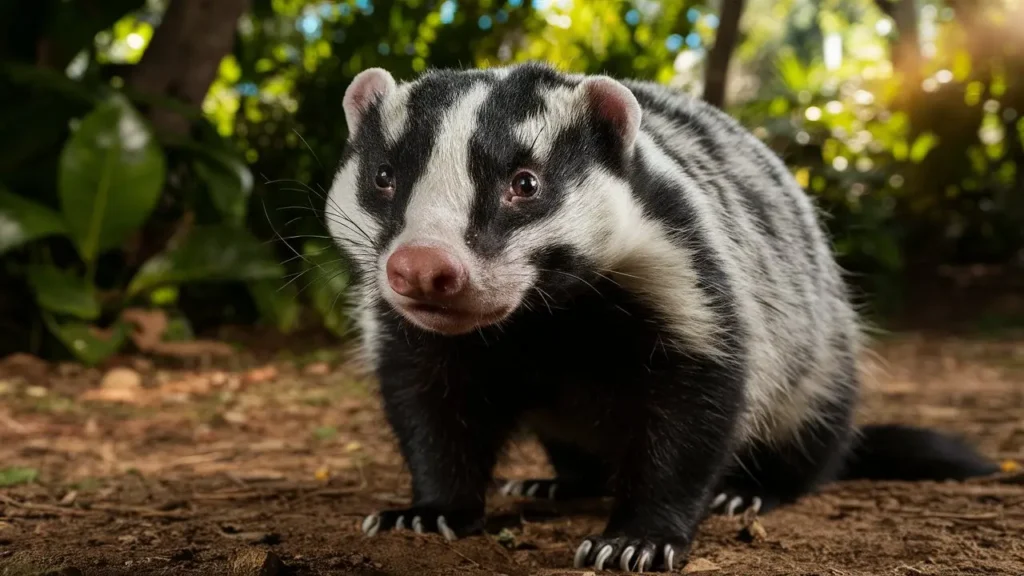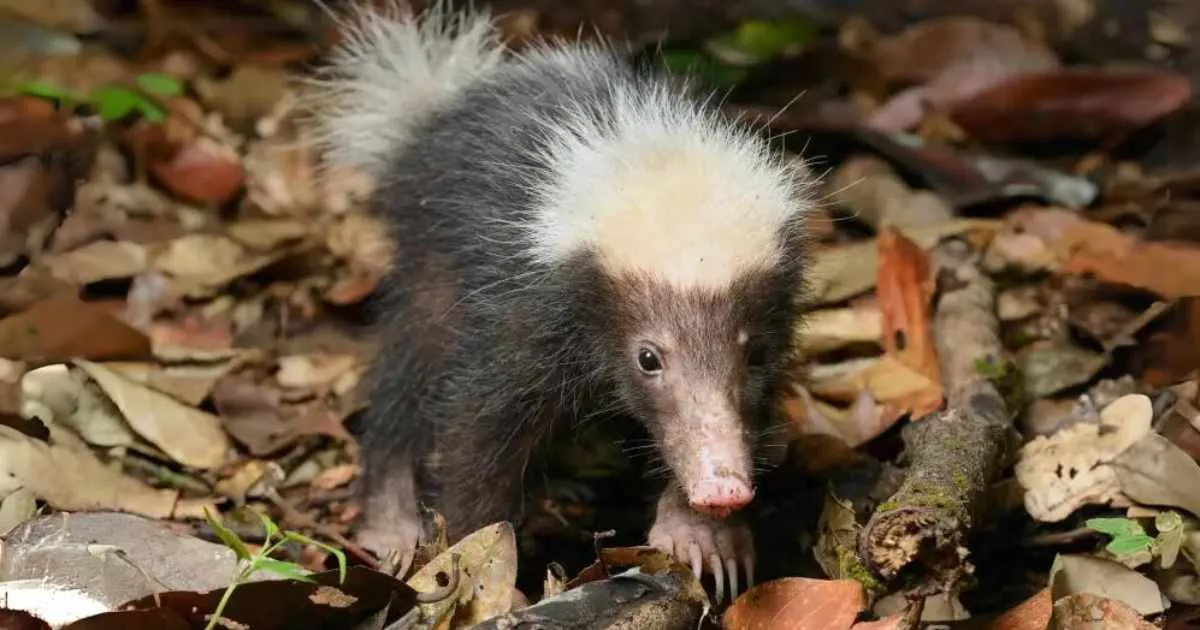Sunda Stink Badger: Southeast Asia’s Elusive Nocturnal Forager
Last updated on December 6th, 2024 at 11:18 pm
Have you ever heard of the Sunda Stink Badger? Found in the dense forests of Indonesia and Malaysia, this fascinating creature combines the traits of skunks and badgers. Known for its potent defense mechanism and nocturnal lifestyle, the Sunda Stink Badger (Mydaus javanensis) is a marvel of nature. Let’s explore its behaviors, habitat, and unique role in the ecosystem.
Mysteries of the Sunda Stink Badger
The Sunda Stink Badger is a secretive mammal that lives a solitary life in Southeast Asia’s tropical rainforests. Despite its name, it’s more closely related to skunks than badgers. Its mysterious nature, coupled with its cryptic behavior, makes it a captivating subject of study for wildlife enthusiasts.
Elusive Habits
During the day, Sunda Stink Badgers hide in burrows they dig with their powerful claws. These burrows are often located in remote corners of the forest, providing refuge from predators and human activities.
Night-Time Activity
At dusk, these mammals emerge to forage. Their keen sense of smell guides them as they search for:
- Invertebrates: Earthworms, beetles, and larvae.
- Small Vertebrates: Frogs and lizards.
- Plant Material: Fruits, roots, and tubers.
Their adaptability in diet ensures survival across varying environments.
Physical Characteristics
The Sunda Stink Badger is a compact and agile mammal, perfectly adapted to its environment.
Size and Appearance
- Length: 37–51 cm (14.5–20 inches).
- Weight: 1.4–3.6 kg (3–8 pounds).
- Fur: Thick, coarse, and predominantly black with a prominent white stripe.
- Tail: Short, used for spreading its defensive spray.
- Nose: Sharp and sensitive, ideal for detecting food underground.
Adaptations for Survival
- Strong Legs and Sharp Claws: Efficient for digging burrows and unearthing food.
- Potent Spray: Releases a foul-smelling liquid to deter predators.
- Compact Body: Helps navigate dense underbrush with stealth and agility.
Behavioral Traits
Defense Mechanisms
The Sunda Stink Badger’s most famous trait is its ability to spray a noxious liquid when threatened. This chemical defense is not only disorienting but can cause temporary blindness in predators.
Key Defense Features:
- Spray Accuracy: Targets predators up to several feet away.
- Warning Signs: Tail-raising and stomping before spraying.
- Long-Lasting Smell: Creates a lasting deterrent to would-be attackers.
Solitary Lifestyle
These mammals prefer a solitary existence, coming together only during mating season. Outside of these periods, they roam and forage alone, marking their territories with scent.

Habitat and Range
Preferred Environments
The Sunda Stink Badger thrives in:
- Tropical Rainforests: Dense vegetation provides cover and food.
- Mountainous Areas: Found at elevations up to 2,100 meters.
- Agricultural Lands: Occasionally adapted to plantations near forests.
Geographic Distribution
These creatures are native to:
- Indonesia: Sumatra, Java, and Borneo.
- Malaysia: Forested areas on the Malay Peninsula.
- Thailand: Highland regions near the southern border.
Dietary Preferences
The Sunda Stink Badger’s diet reflects its adaptability and resourcefulness.
Key Food Sources
- Insects: Earthworms, beetles, and larvae are staple items.
- Fruits and Plants: Roots, tubers, and berries supplement their diet.
- Small Vertebrates: Frogs and lizards add protein variety.
Foraging Behavior
- Nocturnal Activity: Searches for food during the night when prey is most active.
- Digging Skills: Uses strong claws to uncover insects and roots.
- Opportunistic Feeding: Adapts diet based on seasonal availability.
Reproduction and Lifespan
Mating and Offspring
Sunda Stink Badgers exhibit fascinating reproductive behaviors:
- Mating Season: Occurs annually, often triggered by environmental conditions.
- Gestation: Lasts approximately 60 days.
- Litter Size: Typically 2–4 kits born in burrows.
Kits remain dependent on their mothers for several months, learning critical survival skills like foraging and defense.
Lifespan
In the wild, Sunda Stink Badgers can live up to 14 years, although threats like habitat loss and predation can shorten their lifespan.
Conservation Status
Current Threats
Although classified as “Data Deficient” by the IUCN, Sunda Stink Badgers face several risks:
- Habitat Destruction: Logging and agricultural expansion reduce their living spaces.
- Pesticides: Poison food sources and harm their health.
- Hunting: Occasionally targeted for their fur or perceived as pests.
Conservation Efforts
Efforts to protect Sunda Stink Badgers include:
- Protected Reserves: Establishing wildlife sanctuaries in their native range.
- Community Education: Teaching locals about their ecological importance.
- Research Programs: Studying population dynamics to inform conservation strategies.
Fun Facts About Sunda Stink Badgers
- Skunk-Like Defense: Their spray is so potent it can deter predators like leopards and civets.
- Digging Experts: They can excavate complex burrows within hours.
- Misleading Name: Despite being called “stink badgers,” they are more closely related to skunks.
- Diet Diversity: Their omnivorous diet helps them adapt to habitat changes.
- Longevity: They can live over a decade in the wild under favorable conditions.
Frequently Asked Questions
What do Sunda Stink Badgers eat?
They primarily eat insects, worms, fruits, and small vertebrates like frogs and lizards.
Are Sunda Stink Badgers endangered?
Currently, they are classified as “Data Deficient,” meaning there is insufficient information to assess their population status.
Where do Sunda Stink Badgers live?
They inhabit tropical rainforests and mountainous regions in Indonesia, Malaysia, and Thailand.
Conclusion
The Sunda Stink Badger is a testament to the marvels of nature. Its unique behaviors, potent defenses, and vital ecological roles highlight the importance of preserving such species. By protecting their habitats and raising awareness about their significance, we ensure that these fascinating mammals continue to thrive in the lush forests of Southeast Asia.t to the rich tapestry of our planet’s biodiversity.

